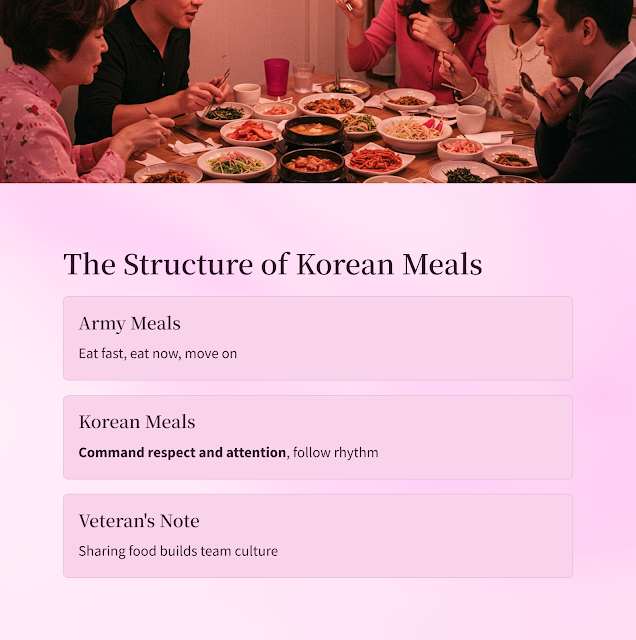Rediscovering my heritage through the flavors of Korea, one dish at a time
How Korean Food Feels Different When You’ve Lived Both Worlds
As a Korean American who served in the U.S. Army and now lives in Korea, food isn’t just fuel — it’s identity, memory, and connection.
Having grown up in the States with weekend kimchi and frozen mandu, then later experiencing Korean food in its native setting, I’ve come to appreciate it on a whole new level.
This post shares my reflections on Korean cuisine from both sides of the Pacific, shaped by a veteran’s discipline and a Korean son’s nostalgia.
The First Shock: How Real Kimchi Tastes in Korea
Growing up, kimchi came from a plastic jar and tasted sharp, salty, and kind of sour.
But in Korea, kimchi is alive, layered, and deeply local.
From house-fermented varieties to region-specific styles like gat-kimchi or bossam-kimchi, the difference is night and day.
What surprised me most as a veteran? The discipline of kimchi-making. Every family has a system, a ritual.
Key insight: True kimchi isn't just fermented cabbage — it's history in a bowl.
Meals in Korea: Structure, Timing, and Purpose
In the Army, food had structure — eat fast, eat now, move on.
In Korea, meals command respect and attention, no matter how simple.
Korean meals follow an unspoken rhythm: start with rice and soup, move through side dishes, finish clean.
It's not just eating; it's checking in with your body and the people at your table.
Veteran's note: Sharing food is more than tradition — it's part of team culture, both in uniform and in Korean homes.
| Meal Aspect | Army Life | Korean Life |
|---|---|---|
| Timing | Fast and fixed | Flexible but deliberate |
| Communication | Minimal | Constant during meals |
| Food Philosophy | Calories first | Balance, flavor, harmony |
The Power of Banchan: Korean Side Dishes with Strategy
At first, I thought side dishes were just appetizers. I was wrong.
Banchan (반찬) are strategic tools — salty, spicy, mild, chewy — each designed to balance the meal.
They keep your palate fresh and your plate interesting, even if you're just eating plain rice and soup.
As a veteran, I respect how this system stretches ingredients, reduces waste, and maximizes flavor.
Essential lesson: In Korea, every small dish earns its place.
Street Food and Soldier Hunger
No matter your background, Korean street food speaks to the hungry soldier in all of us.
From tteokbokki to odeng, these quick bites hit the same emotional note as a hot MRE after a cold march.
But there’s more — it’s affordable, communal, and unpretentious.
Memory lane: I still remember trying sundae (blood sausage) for the first time and being reminded of field rations — oddly familiar, deeply satisfying.
Eating Alone vs. Eating Together – Cultural Shift
In the military, we ate together out of necessity.
In Korea, you eat together out of culture — and choosing to eat alone can sometimes raise eyebrows.
Still, the rise of 혼밥 (honbap, solo dining) shows that Korea is adapting.
As a Korean American, I feel the tension between independence and community — and food sits right at the center of that tug-of-war.
Takeaway: Food is freedom, but also a mirror of where you are — mentally and geographically.
Traditional Korean Dishes That Hit Different as a Korean American
Some foods carried deeper meaning once I experienced them in Korea:
| Dish | Childhood Memory | Korean Experience |
|---|---|---|
| Samgyetang | Occasional flu remedy | Ritual for wellness and seasons |
| Bulgogi | BBQ treat on holidays | Everyday lunchbox flavor |
| Doenjang Jjigae | “Stinky soup” to avoid | Comfort food on rainy days |
Seeing how each dish connects to weather, wellness, and rhythm of life made them more than just meals — they became anchors to heritage.
Final Reflection – Food as Identity Recovery
Living in Korea has given me back something I didn’t know I was missing.
Through food, I’ve reconnected with my roots not as a tourist, but as someone coming home.
As a veteran, I understand the importance of structure, resourcefulness, and sharing — all values deeply embedded in Korean culinary culture.
Final thought: Korean food taught me that identity is not just where you’re from — it's also what you choose to return to.









